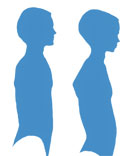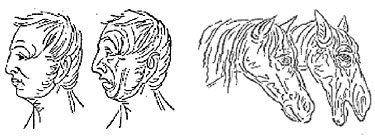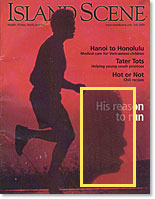
| Mouthpiece -
Patent No. #6,295,988 Oral Shield - Patent No. #6,295,988 Nose Breathe for Heavy Mouth Breather - Patent No. #6,053,168 Tongue Positioner/ Pacifier/Trainer Patent No. #6,412,489 Nose Breathe® Registered Trademark |

Mouth breathing appears harmless, unassuming, benign, and unsuspecting form of breathing. For many, breathing is breathing and it has no relevance whether it is from the mouth or nose. In fact, many will agree that one can get more air from the mouth than through the nose and therefore, it is more efficient. The book used in medical school curriculum: "The Principles and Practice of Sleep Medicine", 4th Edition, does not mention the term mouth breathing at all. The information found in the book has been the base from which past and current research studies have been initiated. It has resulted in thousands of research projects [millions of dollars spent] and we are no closer to understanding the cause of the collapse of the oropharyngeal walls [OSA] and the cause of SIDS as examples.
Understandably, the debilitating affects of mouth breathing may not be widely accepted. Never the less, it needs to come out.
2. "Shut Your Mouth and Save Your Life, Notes of Travels Amongst the North-
American Indians", 1870, George Catlin.
Free download at: www.wt.com.au/~pkolb/buteyko.htm
George Catlin's observations of the North American Indians 150 years ago are
priceless.
3. "Your Jaws Your Life", 2003, David Page, D.D.S.
Order at: www.SmilePage.com
Dr. Page related jaw size to airway, nocturnal enuresis, ear infections, heart
diseases, hypertension, snoring and much more. His claims are supported by
over 300 references. Mouth breathing is the major culprit for the abnormal
development of the jaws.
4. "Back To Sleep" Recommendations for the prevention of SIDS:
Back Sleeping, Breast Feeding, Smoke Free Environment, and Dress infants comfortably, not too hot [keep on the cool side]. The common denominator of these four recommendations is to prevent hyperventilation "mouth-breathing". If mouth breathing occurs, infants are most vulnerable for the tongue to fall back into the throat and cause "accidental suffocation", hence SIDS. For whatever it is worth, the naturally occurring lip seal and tongue suction and the tongue positioned at the roof of the mouth found only during nasal breathing are simple and profound discoveries. In my opinion, SIDS is a form of infant sleep apnea. Why do you think infants are 100% nasal breathers at birth? In the study: "Dummy use, thumb sucking, mouth breathing and cot death", L'Hoir, et al, University Medical Centre Utrecht/Wilhelmina Children's Hospital, The Netherlands, Eur J Pediatr, 1999 Nov;158 (11):896-901. Conclusion: Mouth breathing appears to be associated with an increased risk for cot death. A brief search of the literature has produced these results:
1. Nippon Jibiinkoka Gakkai Kaido, 2004 Jan:107 (1):7-11 "Videofluorography of the pharynx in patients suffering from aspiration pneumonia" Kumai Y, Samejima, Yumoto E.
2. Abdom Imaging. 2003 Mar-April:28 (2):244-7 "Videofluoroscopic evaluation of HIV/Aids patients with swallowing dysfunction" Halvorsen RA Jr, Moillenken SM, Kearney AT.
3. AJR AM J Roentgenol. 2003 Jun;180 (6):1613-6 "Videofluoroscopic studies of swallowing dysfunction and the relative risk of pneumonia" Pikus L, Levine MS, Yang YX, Rebesin SE, Katzka DA, Laufer I, Gefter WB.
4. Pediatrics. 2001 Dec;108 (8):E106 "Swallowing function and medical diagnoses in infants suspected of Dysphagia" Newman LA, Keckley C, Petersen MC, Hamner A.
5. Chest. 2001 Oct;102 (4):1190-5 "Chronic aspiration without gastroesophgeal reflux as a cause of chronic respiratory symptoms in neurologically normal infants" Sheikh S, Allen E. Shell R, Hruschak J, Iram D, Castile R. McCoy K.
6. Cri Care Med. 2001 Sep;29 (9):1710-3 "Postextubation fiberoptic evaluation of swallowing after prolonged endotracheal intubation: a randomized, prospective trial" Barquist E, Brown M, Cohn S, Lundy D, Jackowski J.
Associated terms: asthma, nocturnal asthma, diurnal changes, nocturnal suffocation, apnea, COPD, cough, wheezing, heartburn, chest pain, laryngopharyngeal reflux, laryngitis, ulceration, granuloma, laryngeal carcinoma, chronic hoarseness, pharyngitis, bronchitis, nocturnal choking, dental diseases. 1. Sleep. 2003 Dec 15;26(8):939-40 "Association between nocturnal bruxism and gastroesophageal reflux: Miyawaki S, Tanimoto Y, Araki Y, Katayama A, Fujii A, Takano-Yamamoto T.
2. Am J Respir Med. 2003;2 (2):117-21 "Clinical implications of gastroesophageal reflux disease and swallowing dysfunction in COPD" Mokhlesi B.
3. Eur J Gastroenterol Hepatol. 2002 Sep;14Suppl 1:S23-7 : "Laryngopharyngeal manifestations of reflux: diagnosis and therapy" Close LG.
4. Chest. 2002;122:2266-2267 "Nocturnal Gastroesophageal Reflux: Symptom of Obstructive Sleep Apnea Syndrome in Association with Impaired Swallowing: Teramoto S, Haruki K, Yasuyoshi O.
5. Chest. 2002;121:8-11 "Sleep-Related Breathing Disorders: Is it all about apnea?" Orr W.
6. Chest. 2003 Mar;123 (3Supp):399S-405S "Nocturnal asthma" Calhoun WJ.
7. Larngorhinootologie. 2003Feb;82(2):118-22 "Gastroesophageal reflux - a common illness?" Issing WJ
Associated terms: deleterious habits, mouth breathing, atypical swallowing, malocclusion, tonsil hyperplasia, OSA, snoring, speech problems, elongated-narrow face (Adenoidal face), high palate, mandibular retrognathia, deviated septum, protrusion, aspiration, oxygen desaturation.
1. Cad Saude Publica. 2004 May-Jun;20(3):689-97 "The relationship between oral habits, oronasopharyngeal alterations, and malocclusion in preschool children in Vitoria, Espirto Santo Brazil" Emmerich A, Fonseca L, Elias AM, de Medeiros UV.
2. An Otorhinolaryngol Ibero Am. 2004;31(3):265-82 "Respiratory orofacial and occlusion disorders associated with adenotonsillar hypertrophy" Gonzales Rivera SR, Coromica Iser J, Gay Escoda C.
3. Eur Arch Otorhinolaryngol 2003 Mar;260(3):124-7 "Pulse oximetry monitoring for the evaluation of swallowing function" Higo R, Tayama N, Watanabe T, Nito T.
4. Dysphagia. 2003 Summer;18(3):169-78 "Eating and breathing: interactions between respiration and feeding of solid food" Palmer JB, Hiiemae KM.
5. Bull Tokyo Dent Coll. 2003 May;44(2):43.54 "Malocclusion associated with abnormal posture" Yamaguchi H, Sueishi K. What appear to be unrelated events (diseases) are related. Sometimes the obvious are the most difficult to see. Historically, many are not able to see the forest from the trees, though many think they do. Our successful gene pool is designed for inclusive fitness, that is, ones chance for survival is to be accepted in the pack. Studies show that abnormal swallowing, aspiration, GERD, and malocclusion occur together and, are classified as separate diseases. A simple analogy to this: some are studying the roots of the trees, while others are studying the branches, the leaves, the barks; some are studying the cells and others the chemical make up. The studies are so specialized that no one sees the tree anymore and, so far removed from ever seeing the forest. As the diseases are broken down into smaller and smaller components, new and more powerful drugs are being designed along the way for ones consumption. Compartmentalized knowledge is not unique in our society. In fact, the more specialized one becomes, the greater the inherent value.
Much of what I share is my observations from the work done with the discovery of Nose Breathe Technology. Some can be substantiated and others are my opinions. Mouth breathing is the wolf at the door. Would it not be beneficial to base some of our future studies [National Institute of Health (NIH) sponsored] that would focus on the relationship [connection] between mouth breathing and OSA, aerophagia, bloating, burping, flatulence, acid reflux, LPR, CFS, fibromyalgia, silent aspiration, pneumonia, bronchitis, stridor, colitis, chronic cough, hiccups, asthma, hormonal imbalance, diabetes, bed wetting, malocclusion, deviated septum, adenoidal face, recessive chin, heartburn, high blood pressure, stroke, SIDS,?
Tongue thrust is natural in infants [infantile swallowing]. When the infant first starts to eat solid food, food spills out of the mouth. All mothers are aware of this because one must scoop the food off the lips with a spoon and place it back into the infant's mouth. Tongue thrust serves a useful purpose in infants because it keeps the tongue from falling back into the throat and help with swallowing because the oropharyngeal [throat] regions are growing at a rapid rate. At about six months, the infants start to outgrow the tongue thrust and start to place the tongue at the roof of the mouth [as found in normal swallowing] to help shape and develop the cranio-facial [head and neck] structures. This is done automatically as determined by genetic codes. [The early cranial development is vital for the normal development of the hypothalamus and pituitary gland. This is the "Master Switch" that controls and regulates the basic functions of the body. For protection, nature positions it deep at the base of the cranium]
In normal swallowing [tongue placed at the roof of mouth], peristaltic waves are created that sends the bolus of food straight down the esophagus and into the stomach. Tongue thrust [infantile swallowing] does not generate normal peristaltic activity causing trapped air to be taken into the stomach and particles (mists) could be taken into the trachea and lungs from the partial closure of the epiglottis. Man swallows 2000 times a day. This is a lot of air that is being swallowed by mouth breathers. Eventually [long-term], pressure [excessive pressure] inside of the stomach [bloating] pushing against the esophageal sphincter [from the inside] will cause it to weaken and a leakage will occur [acid reflux results], mild at first. The continuous assault of stomach fluid on the pharyngeal lining [walls of the throat] will cause the throat to lose its elasticity and the resulting stiffness to the walls will cause it to collapse as found in moderate and severe OSA. In severe apnea, it is more than the tongue that is causing the blockage. It is the entire pharynx that could collapse. Aspiration [precursor to pneumonia, emphysema,] of foreign particles (mists) and fluid into the lungs would also explain for the lost of elasticity of the lungs found in COPD. We are dealing with a myriad of illnesses that are connected to each other. These are not separate illnesses (diseases) which require a host of treatment (medication, surgeries,).
Start with mouth breathing / tongue thrust / retained-infantile-swallowing and one could construct a path to ones illness. If just one percent takes it to heart, it would empower one to understand and take responsibility of ones health. Many of ones illnesses are preventable [Watching what one eats is for another time]. It is worth repeating that the most effective way to control the tongue during swallowing is through nasal breathing. Nasal breathing places the tongue at the roof of the mouth where there is the naturally occurring lip seal and tongue suction. During swallowing the tongue presses against the roof of the mouth and sends a normal and powerful peristaltic wave [starting at the tongue and transmitting the energy along the oropharynx] sending the bolus of food straight into the stomach without trapping any air. The anatomy of the oral cavity is designed for eating and genetically determined. As with any machinery [organ] that is not used the way it was designed, will result in premature wear and tear; once the breakdowns occur, it will affect the functions of the entire machine [organism].
The biggest complaints I hear are I cannot swallow with the tongue in that position and I gag. I have excessive saliva. Mouth breathers cannot swallow with the tongue is this position because they tongue thrust [retained infantile swallowing]. Mouth breathers have difficulty swallowing pills. Another tell-tale sign of mouth breathing, the lower lip needs to be constantly licked because of dryness. Others have said I am a nose breather by day and a mouth breather at night. Once one experiences what it is to be a pure nose breather, one will realize how much during the day one is mouth breathing. [V. Weatherford, Comments] Without the willingness to look within [at oneself] and make the necessary lifestyle changes, merrily, one will continue along the calf-path as all good bell-wethers do. Needless to say, many will suffer terribly.
Dr. Sue's INTERVIEW: as published in Dentaltown, a professional magazine that goes to all the dentists and dental hygienists in the US. "I have had my NB for several months now and it is amazing. I had forgotten what it was like to wake up with a moist mouth and fresh feeling. I have forgotten it on a couple of occasions while traveling and been miserable. I am ordering a second NB so I can keep one in my travel kit. What a great product! My life has changed for the better because of it."
"I've been using my NB/HMB for over four years and still get excited when I explain to someone how wonderful it is. I look forward to every night's sleep with my mouthpiece knowing that I am going to sleep soundly and wake up feeling great! The NB/HMB has cured my sleep apnea problems at a time that I lost hope that anything would work. Prior to using my NB/HMB, I always dealt with snoring, nasal congestion, and sore throats which contributed to allergies. Now all of those symptoms are gone and I haven't had a sore throat in years. It is amazing! Thank you Dr. Sue for this wonderful device. It has truly changed my life."
"I have been using the NB/HMB for two years. It eliminated my sleep apnea and helped boost my immune system. I get a good night's sleep, have less sinus congestion, and am less prone to allergies and catching colds. I coped with nocturnal seizures for years that occurred during sleep, especially when congested. Because the NB/HMB regulates my breathing and keeps my airway open, my oxygen intake has increased and my seizures have decreased. Recently my doctor has reduced my seizure medication and stopped my nasal sprays. This little plastic device has been an amazingly simple solution to my complicated medical problem. It is small, compact, portable, and I take it whether I am traveling or sleeping overnight at family without worrying about lugging a bulky machine like my husband does. I am enjoying a new sense of wellness than ever before!"
"My husband has been using the NB/HMB for several months. It virtually has eliminated his very loud snoring, and we believe it has reduced his apnea episodes [this is based on how much better he feels, my personal observations; although it has not been verified by a sleep study]. Thank you for such an amazing product. It greatly has improved the quality of both our lives."
"I received my NB about 2 weeks ago and it is working very well in conjunction with my CPAP. It has helped my dry mouth. Thank you for developing this appliance."
"I really like the tongue Trainer, NB/T. Thank you so much. I use it every night and it allows me to relax at night. Happy customer in Sweden."
"I could not be happier with the tongue Trainer (NB/T). It is very comfortable to wear. It is very effective in stopping my mouth breathing. I have tried other products such as chin straps to stop the mouth breathing. Nothing else worked until I got your device. It has made such a huge difference in the quality of my life. Mouth breathing is so unhealthy. With this device I am now back to nose breathing. I can't say enough about this simple tongue Trainer. For anyone who has a problem with mouth breathing, this is the answer."
"Nancy Henderson, MFA Rancho Santa Fe, CA has written an excellent article on nasal breathing for Weston A. Price Foundation, Wise Traditions: "100 YEARS BEFORE WESTON PRICE", Fall 2009
|
||||||||||||||||||||||||||||||||||||||||||||||







